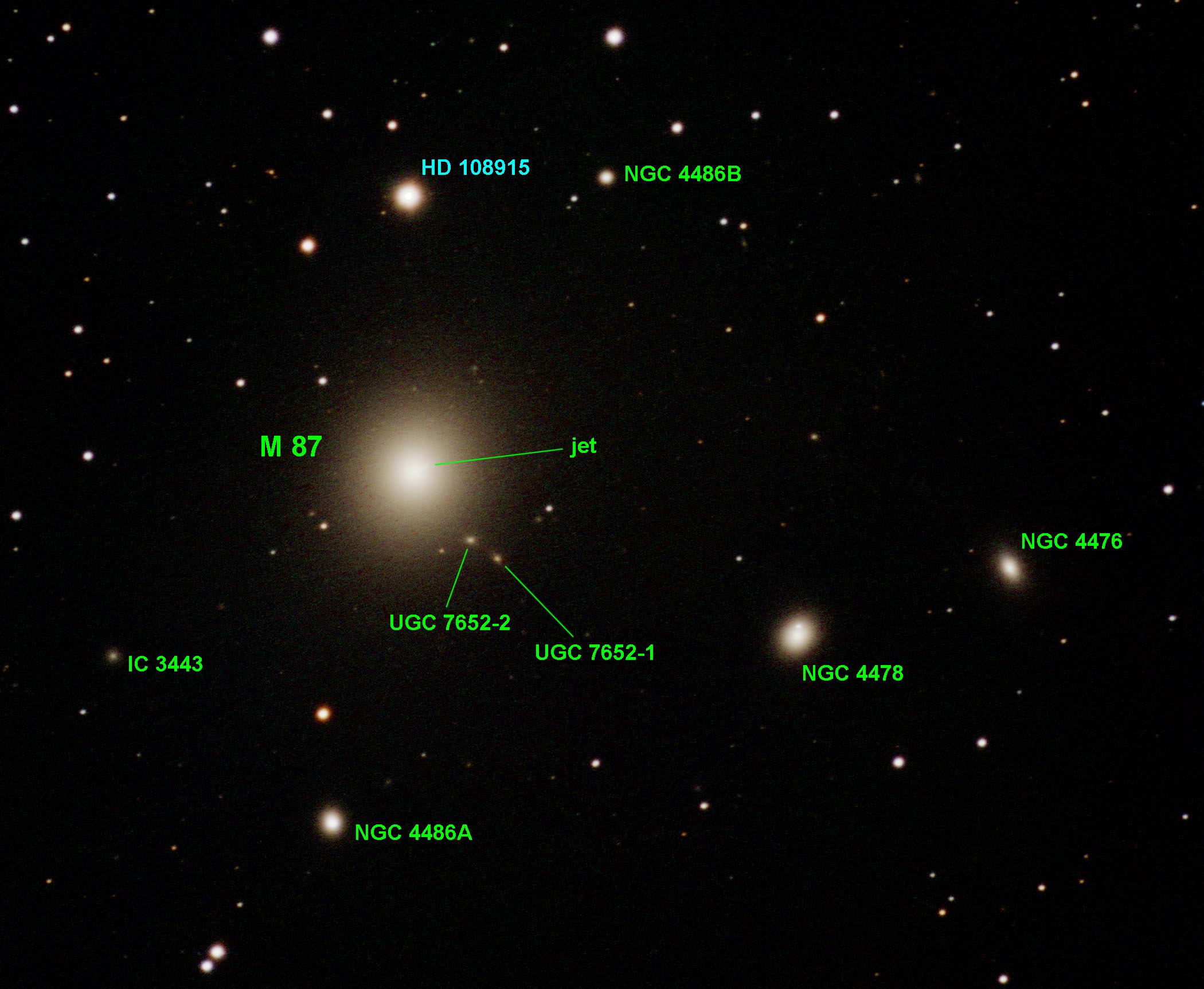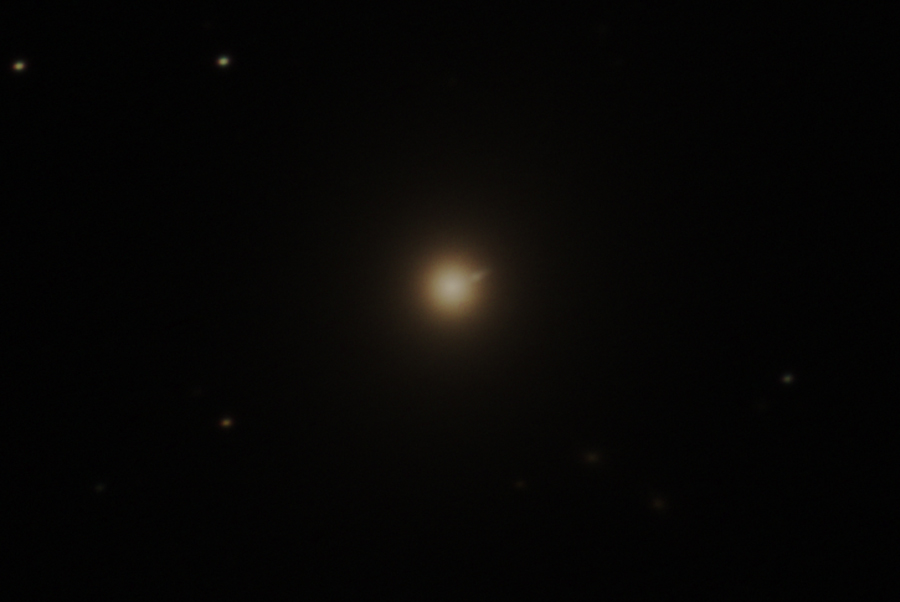
 | SOCO Blog |
04 April 2016
M 87 AND ITS JET
It's springtime and that means one thing to astro-imagers— galaxies. The Spring sky is teeming with them, in part due to the presence of the Virgo Supercluster lying across the borders of the constellations Virgo and Coma Berenices. Our Local Group of galaxies, including the Milky Way, lies along the edge of this supercluster. The core of the supercluster comprises the Virgo Cluster, which contains around 2000 galaxies. M 87 (NGC 4486) lies at the center of this group and is the largest and most massive member. M 87 is a giant elliptical galaxy and is the most massive galaxy in our part of the Universe. It has a diameter of around 132,000 LY, which is about 30% larger than our Milky Way Galaxy. However, since M 87 is an elliptical galaxy (essentially a sphere) and not a flattened spiral galaxy like the Milky Way, it contains a much greater volume of material. Estimates indicate that M 87 contains the equivalent of 2-6 × 1012 solar masses. M 87 also has a large number of globular clusters surrounding it (12,000 compared to 150-200 for the Milky Way). M 87 is definitely the heavyweight in our part of the Universe.
My image of M 87, acquired on the night of April 3, is presented in Figure 1. This image was created from six 15-minute exposures in each of the red, green and blue spectral bands. The whole imaging session lasted from around 10 PM on April 3 to around 3 AM on April 4. In addition to M 87, a number of smaller galaxies were captured in the image. The main galaxies in the group are labelled in Figure 2. There are also several faint galaxies scattered about the image, appearing as little more than tiny glowing spots on the verge of resolution. Figure 2 also indicates the only reasonably bright star in the vicinity, HD 108915 (in my image, overexposed due to the long exposure times needed to adequately capture the galaxy). This spectral class K0 star has a visual magnitude of 8.65 and lies at a distance of 593 LY. For comparison, M 87 lies at a distance of 54.9 million LY.

Figure 1. The large elliptical galaxy M 87 in the constellation Virgo.

Figure 2. M 87 and surrounding smaller galaxies.
M 87 was formed some time in the distant past by the collision and merger of two other large galaxies. Most elliptical galaxies are believed to be the result of mergers, including mergers of spiral galaxies. When our Milky Way Galaxy eventually collides with the Andromeda Galaxy (M 31), the merger will result in a large elliptical galaxy like M 87. At the heart of M 87 is one or possibly two supermassive black holes (left-overs from the merged galaxies). The black hole(s) give rise to a unique feature that makes M 87 a more interesting object than just a uniform glowing ball of stars and dust. This is the presence of a gigantic jet of hot plasma shooting out from the center of the galaxy. This jet extends 65,000 LY from the galaxy core and glows with the blue light of synchrotron radiation emitted by electrons caught is strong magnetic fields. A detailed view of this jet acquired by the Hubble Space Telescope is presented in Figure 3. While the galaxy was discovered by Messier in 1781, it wasn't until the detailed observations by the American astronomer Heber Curtis in 1918 at Lick Observatory that the jet was discovered.

Figure 3. A Hubble Space Telescope view of the plasma jet emitted by the core of M 87.
Source: NASA and The Hubble Heritage Team (STScI/AURA).
Normally, I consider features of astronomical objects observed using Hubble to be a bit "out of the league" of the modest SOCO telescope and imaging system. But surprisingly, the jet does show up well in the imagery of M 87 that I acquired. It is not readily visible in Figure 1 because it is drowned out by the overall glow of the galaxy in this view. However, if I process the image to show mainly the core of the galaxy (as has been done in Figure 3), the jet can easily be seen. Figure 4 centers on the core of M 87 from Figure 1 processed to bring out the jet. OK, I know it's not as good as NASA's image in Figure 3— but I'm amazed that I could capture it at all! It says a lot for steady skies and good scope guiding. And, analyzing the color of the jet in Figure 4 using Photoshop, it does turn out to be slightly bluer than the rest of the galaxy.

Figure 4. The core of M 87 from my imagery processed to show the plasma jet.
Actually, many people have thought that they've seen the jet visibly in moderate-size telescopes. Unfortunately, what they've actually seen is the pair of small galaxies (UGC 7652-1 and UGC 7652-2) lying along the lower right side of M 87 in Figure 2 which, under typical viewing conditions, might be confused with it. However, as my imagery shows, the jet is actually very close to the galaxy core and not out along the edge of the galaxy.
To me, elliptical galaxies are pretty boring— one glowing ball looks about the same as the next. But the presence of the plasma jet makes M 87 a very interesting object, if for no other reason than just the challenge to be able to spot it. I'm really please that I was able to capture such a spectacular feature.
 Return to SOCO Blog Page
Return to SOCO Blog Page
 Return to SOCO Main Page
Return to SOCO Main Page
Questions or comments? Email SOCO@cat-star.org